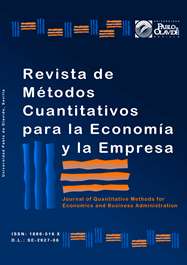Business Growth and Corruption: An Analysis for the Manufacturing Colombian Industry during the period 2000-2011
DOI:
https://doi.org/10.46661/revmetodoscuanteconempresa.2214Keywords:
Crecimiento empresarial, responsabilidad social empresarial, corrupción, sector manufacturero, productividad, business growth, corporate social responsibility, corruption, manufacturing sector, productivityAbstract
This paper shows the relationship between business growth and private corruption in the manufacturing industry in Colombia. This study investigates the dynamics of these variables using various techniques by implementing empirical models: estimations via panel data estimates and modeling with dynamic panel data. The technique of panel data is implemented to estimate growth in the manufacturing business using capital, employment and entrepreneurship as decision variables; this also evaluates the performance of the different interactions and the changes caused in business growth in the sectors that make up the industry to identify trends. The analysis of dynamic panel data is performed to determine the variables that affect business growth. The estimation of the panel data model shows that the selected variables to calculate business growth fit with the theoretical framework proposed in this research. The dynamic panel data model applied here reveals that in manufacturing, higher levels of private corruption have an impact on business growth; overall trends show that corruption, its effects over time and incidence rates in the industry, affected negatively the business growth of each sector analyzed in the period from the year 2000 to 2011.
Downloads
References
Alexeev, M y Song, Y (2013). Corruption and product market competition: An empirical investigation. Journal of Development Economics 103, 154–166.
Arellano, M. y Bond, S. (1991). Estimation of dynamic models with error components, Journal of the American Statistical Association 76, 29–52.
Arellano, M. y Bover, O. (1995). Another look at the instrumental-variable estimation of error components models, Journal of Econometrics 68, 29–52.
Barney, J. (2001). Resource-Based Theories of Competitive Advantage: A Ten-Year Retrospective on the Resource-Based View. Journal of Management 27, 643–650.
Blázquez, S.F.; Dorta, V.J. y Verona, M.M. (2006). Concepto, perspectivas y medida del crecimiento empresarial. Cuadernos de Administración. 19(31), 165–195.
Corporación Transparencia Por Colombia (2012). Medición de Transparencia Empresarial en Empresas de Servicios Públicos. Recuperado en febrero 20, 2013 disponible en http://www.transparenciacolombia.org.co/index.php?option=com_content&view=ar ticle&id=92:medicion-transparencia-empresarial&catid=82:mediciones-y-cifras&Itemid=500
Corporación Transparencia Por Colombia y Universidad Externado de Colombia. (2010). Segunda encuesta nacional sobre prácticas contra el Soborno en empresas Colombianas. Recuperado en febrero 20, 2013 disponible en http://transparenciacolombia.org.co/images/publicaciones/sector_privado/cuaderno 19_segunda_encuesta_soborno.pdf
Fischer, S (1993). The role of macroeconomic factors in growth. Journal of Monetary Economics 32, 485-512.
Imam, P. y Jacobs D. (2007). Effect of Corruption on Tax Revenues in the Middle East. International Monetary Fund. IMF Working Paper, WP/07/270.
Kroll Advisory Solutions, (2012). Informe Global Sobre Fraude. Recuperado en febrero 27, 2013 disponible en http://es.krolladvisory.com/library/INFORMEGLOBALSOBREFRAUDE2012_13.pdf
Ministerio del Interior y de Justicia, (2011). Estatuto Anticorrupción. Recuperado en febrero 20, 2013, disponible en http://186.116.129.19/c/document_library/get_file?&folderId=49245504&name=D LFE-35764.pdf
Solano, D. (2005). Responsabilidad Social Corporativa: Qué se hace y Qué debe hacerse. Cuadernos de Difusión 10, 163-175.
Downloads
Published
How to Cite
Issue
Section
License
Copyright (c) 2015 Revista de Métodos Cuantitativos para la Economía y la Empresa

This work is licensed under a Creative Commons Attribution-ShareAlike 4.0 International License.
Submission of manuscripts implies that the work described has not been published before (except in the form of an abstract or as part of thesis), that it is not under consideration for publication elsewhere and that, in case of acceptance, the authors agree to automatic transfer of the copyright to the Journal for its publication and dissemination. Authors retain the authors' right to use and share the article according to a personal or instutional use or scholarly sharing purposes; in addition, they retain patent, trademark and other intellectual property rights (including research data).
All the articles are published in the Journal under the Creative Commons license CC-BY-SA (Attribution-ShareAlike). It is allowed a commercial use of the work (always including the author attribution) and other derivative works, which must be released under the same license as the original work.
Up to Volume 21, this Journal has been licensing the articles under the Creative Commons license CC-BY-SA 3.0 ES. Starting from Volume 22, the Creative Commons license CC-BY-SA 4.0 is used.










